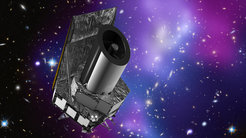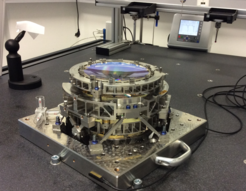MPE contribution to Euclid takes next hurdle

Artist's impression of the Euclid satellite, against a background of galaxies.
A large portion of the universe consists of "dark" components, which astronomers have been able to “see” only through their effects on visible matter: "dark matter" holds galaxies and galaxy clusters together because of its added gravitational pull and is a critical component for the growth of structures in the universe; "dark energy" is responsible for the accelerated expansion of the universe today. Together, these two components account for about 95% of the total density of the universe – but their nature remains largely unknown.
The aim of the ESA mission Euclid is to explore precisely these two mysterious components, in particular their distribution in space and their evolution over cosmic times. For this purpose, Euclid will map the universe and in particular galaxies and galaxy clusters in more detail than ever before. Two cutting-edge instruments, an imaging camera for visible light (VIS) and a near-infrared spectrograph including a photometer (NIS), with a large field of view will provide valuable data.

The complex optics developed at the Max Planck Institute for Extraterrestrial Physics for the near-infrared instrument NISP aboard the Euclid space telescope has passed the Critical Design Review.
The Max Planck Institute for Extraterrestrial Physics (MPE) is responsible for the complex optics for the near-infrared instrument NISP aboard Euclid. The optics consists of four lenses of about 17cm in diameter and has been developed in recent years by a team at MPE. It is implemented in cooperation with OHB Munich and the Carl-Zeiss Jena GmbH. During the recently successfully passed review, the optics itself as well as the concepts for adjustments and for verifying image quality received top marks. The project is now entering its construction phase.
"We are quite proud that we were the first subsystem for the instrument to successfully complete our CDR," says Dr. Frank Grupp, who is the responsible optical architect of the instrument and leading the German project. “But this does not mean that we are already at the end - the challenges posed by this very complex system are enormous. In its size and accuracy, it is unique; such a system has never flown before."
The optical system consists of a corrective optics module and the actual camera lens assembly. There are also modules for filter and grating prisms, a calibration unit and a unit for thermal control, which ensures that the optical system is kept at a constant temperature of 140K. A fixed team with eight employees at the institute and partially significantly larger groups at the industrial partners have been working for up to six years on the project, which has made a large step closer to realization.
"We managed to convince the experts at the space agencies in France, Italy, Spain and the European Space Agency ESA, that our approach is the right one," says Frank Grupp. "Our previous experiments have paved the way for Euclid and the instrument; therefore we can now start with the actual construction of the system."
The German participation in EUCLID is sponsored by the German Centre for Aerospace DLR.













